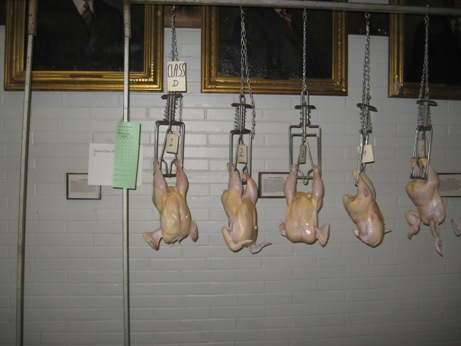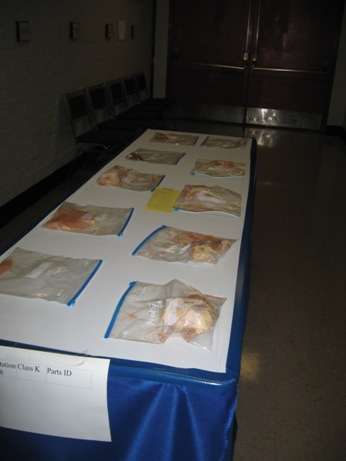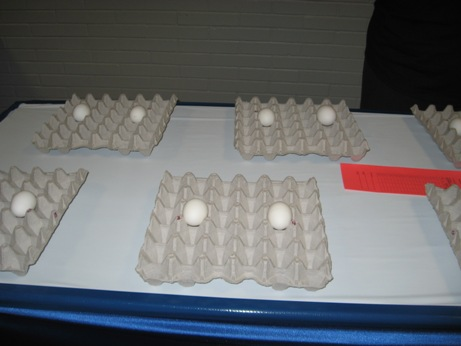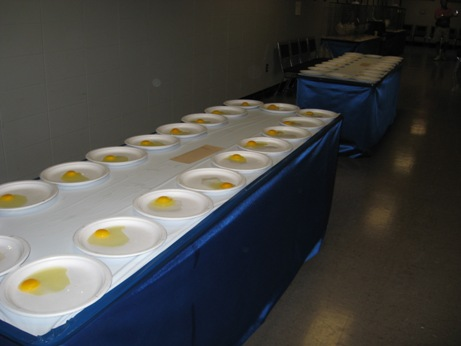Kentucky 4-H - Poultry Judging Contest
DATE and LOCATION:
The Kentucky 4-H Poultry Judging Event is held on the first Friday of the Kentucky State Fair at the Kentucky State Fairgrounds, Louisville, Kentucky. ELECTRONIC REGISTRATION IS COMPLETED THROUGH THE STATE FAIR
The top four senior judges will have the opportunity to represent the state of Kentucky at the National 4-H Poultry Conference to be held on the third Thursday of November in Louisville. To qualify to represent Kentucky in the national event, a 4-H’er must participate in the state event. An all-star team is selected to represent Kentucky in the national event. Selected participants are required to work with the state specialist to prepare for the national event.
DESCRIPTION:
Judging is a tool used to develop 4-H club members. Participation in judging and other competitive events helps 4-H’ers learn to make and defend decisions and to speak in public. Poultry judging provides an excellent opportunity for 4-H’ers to learn about live birds and the basis of grade and quality of poultry products.
The material used in the development of the 4-H Poultry Judging event comes from the revised National 4-H Poultry Judging Manual (contest revised December 2020 with new classes and modifications to current classes. The manual is available online only - at no cost.
OBJECTIVES
- To develop youth and help them learn the techniques of logical, accurate decision making; to learn to recognize the reasons for their decisions, and to develop the ability to express their reasons orally.
- To help youth learn and understand standards used in poultry and egg production and marketing, and to apply the standards in a realistic decision-making situation.
- To serve as an award activity and trip for youth who have achieved superior levels of performance in competition and thus stimulate the learning process, interest, and enthusiasm.
- To help youth with career guidance.
- To promote the poultry industry.
RULES AND INFORMATION SPECIFIC TO THE POULTRY JUDGING EVENT
- Each county is eligible to enter 4-H members in the event.
- 4-H members who enroll in or otherwise receive training in a poultry course at the college level or vocational level above high school are not eligible to participate in this event.
- Participants do not have to be enrolled in poultry projects and are not required to have conducted a poultry project in the current year.
- The event will consist of the following three divisions: Production (300 pts.), Market Poultry (500 pts.), and Market Eggs (500 pts.)
- The classes to be judged are listed at the end of this section.
- Placing cards will be provided for all participants. Each participant will write their placing on the proper card and hand it to the monitor before shifting to the next class. Contestants must provide their own pencils and clipboards. They will not be provided at the contest.
- Teams will be divided so that no two participants from a county will be in the same group. Each group must remain together throughout the event.
- Ten minutes will be allowed for placing each class. Also, each participant will have a maximum of two minutes for giving oral reasons on class B. Participants will shift to the next class only upon notification by the event monitor.
- Qualified judges will listen to and score oral reasons on the second production class (Class B). No name, county, or area identification will be worn by the participants in the oral reasons room. Senior division participants will not be allowed to use notes for oral reasons. Junior participants may use notes. A note-taking sheet will be provided.
- A competent committee will be in charge of grading the cards, announcing the results, and presenting the awards.
- Each class of hens and eggs will be graded on the basis of 100 points for a perfect score. Similarly, oral reasons on the production class will be graded on the basis of 100 points for a perfect score.
- If a participant checks more than one placing for any of the production classes, the lowest score will be the one recorded. If nothing is checked, the participant will receive a zero.
- In case tie scores occur, the ties will be broken by the following method in the order listed:
- The participant with the largest number of 100 scores will win.
- The participant with the largest number of the next highest score below 100 will win. If necessary, this method will be continued in the order of descent of scores.
- A method will be decided upon by the event committee
Classes A and B: Egg Production and Reasons

Four hens per class will be judged for past production. The hen that has laid the most eggs to date should be placed first. Hens may be handled. If a participant checks more than one placing, the lowest score will be recorded. All participants will give oral reasons for the Class B group of hens. Senior division participants will not be allowed to use notes for oral reasons. Junior participants may use notes.
Classes C and D: Grading Ready-to-Cook Carcasses
There will be one class of 10 broiler carcasses and one class of 10 roaster carcasses for grading. Each individual carcass is to be classified A, B, C, or No Grade according to U.S.D.A. Standards for R-T-C Poultry. Carcasses are not to be handled. In scoring the class, three (3) points will be deducted for each grade separation line crossed between A-B and B-C. Four (4) points will be deducted for crossing the C-No Grade line. For example, if the correct answer was No Grade and the contestant selected Grade B, three points would be deducted for crossing the B-C line and four points for crossing the C-No Grade line, leaving the contestant with a score of three points. If the correct answer was Grade C and Grade A was selected, three points would be deducted for crossing the A-B line and three points for crossing the B-C, leaving the contestant with a score of four points. Ten (10) points will be deducted if a contestant fails to enter a grade for a carcass or more than one grade is entered.


Class E: Ready-to-Cook Parts Identification
Contestants will be required to identify 10 chicken parts selected from the 24 possible parts listed in the revised National 4-H Poultry Judging Manual. Each part will be displayed in a ziplock bag. The ziplock bags may NOT be touched or handled.

Class F: Grading Ready-to-cook parts
Contestants will Grade 10 RTC poultry parts according to USDA standards for parts, as A, B, C, or No Grade. Each part is worth ten (10) points. In scoring the class, three (3) points will be deducted for each grade separation line crossed between A-B and B-C. Four (4) points will be deducted for crossing the C-No grade line. For example, if the correct answer was No Grade and the contestant selected Grade B, three points would be deducted for crossing the B-C line and four points for crossing the C-No grade line, leaving the contestant with a score of three points. If the correct answer was Grade C and Grade A was selected, three points would be deducted for crossing the A-B line and three points for crossing the B-C, leaving the contestant with a score of four points. Ten (10) points will be deducted if a contestant fails to enter a grade for a carcass or more than one grade is entered.
Class G: Evaluating boneless further processed products, identifying defects.
Contestants will evaluate 10 plates with different boneless, further processed chicken products. Each product is worth ten (10) points. There are five possible factors and each factor is worth two (2) points. For each factor, the contestants are to indicate if it is present or not.
Classes H and I: Eggs, Exterior Quality
Two classes of 20 shelled eggs are to be judged A, B, Dirty, or Loss based on shape, shell texture, and cleanliness. Any color eggs can be used in the contest. Eggs cannot be handled or touched. The eggs will be presented on flats and are evaluated based on the visible portion of each egg only. Each egg in a class is worth five points. In scoring the exterior egg quality class, two (2) points will be deducted when the A and B grade separation line is crossed. Two (2) points will be deducted when the line between "B" and "Dirty" is crossed. One (1) point will be deducted when the line between "Dirty" and "Loss" is crossed. Five (5) points will be deducted if a contestant fails to enter a grade for an egg or more than one grade is entered for the same egg.


Classes J and K: Eggs, Interior Quality
Two classes of 20 white-shelled eggs are to be candled and evaluated as U.S.D.A. Grades AA, A, B, or Loss. One point will be deducted for each grade separation crossed except the B-Loss line which will be a three-point deduction.
Class L: Eggs, Broken Out
One class of 20 eggs will be broken out and are to be Graded AA, A, B, or Loss according to USDA standards. Eggs will be individually displayed on plates. Neither the eggs nor the plates can be touched or handled. A three-point deduction will be made for each grade separation line crossed except when the B-Loss line is crossed, then there is a three-point deduction.

RELEVANT RESEARCH
Life-Skill Development Found in 4-H Animal Judging
Abstract
A study was conducted in Idaho to determine the impact of the 4-H animal judging program on the life skills of former participants and how judging influenced their lives. The results of the study show that the judging program has affected the development of animal industry knowledge and is at least moderately influential on the development of communication, decision-making, problem solving, self-discipline, self-motivation, teamwork, and organization. All these skills have been recognized as beneficial life skills associated with workforce preparedness. Over 97% of the judging alumni indicated that the Idaho 4-H judging experience positively influenced their personal success.
How do we know if our contests are 'fair'?
Abstract
Adults are often forthright with their concerns about the fairness of contests. In the case study reported here, clients were upset about the Master Showmanship Contest and whether "goat members always win." I predicted that, in a fair contest, winning should be independent of project area and used empirical tests to show that it is. I also measured the perceptions of two additional groups of stakeholders in the contest: youth participants and judges. The results indicate that perceptions can differ drastically from actuality, which has ramifications for 4-H and all areas of Extension work that rely on client input.
Attributes of Indiana's 4-H Livestock Judging Program
Abstract
This article describes the degree of influence Indiana's 4-H livestock judging program had on developing 10 life skills associated with workforce preparedness, profiles 185 alumni of the 4-H judging program, and documents the beneficial attributes of the judging program by listing qualitative responses from former 4-H livestock judges. The majority (>80%) of the respondents were college-educated men between the ages of 21 and 50. According to the alumni, Indiana's 4-H livestock judging program was highly influential in the development of the following skills: the ability to verbally defend a decision, livestock industry knowledge, oral communication, and decision making.
Abstract
Well developed writing skills are in high demand in the professional workplace, yet American students continue to struggle with this important life skill. While 4-H has an exceptional history of teaching oral communication skills, writing has become the neglected life skill. If 4-H is to help its members succeed in all areas of communication, writing must move beyond the realm of the record book and be given a more central role in program planning.
